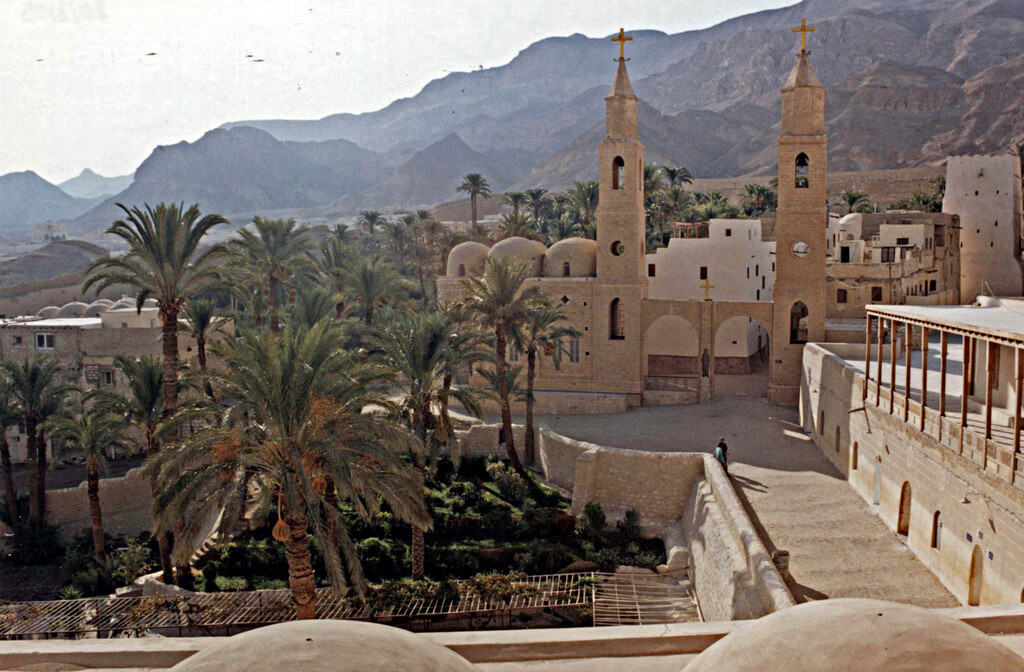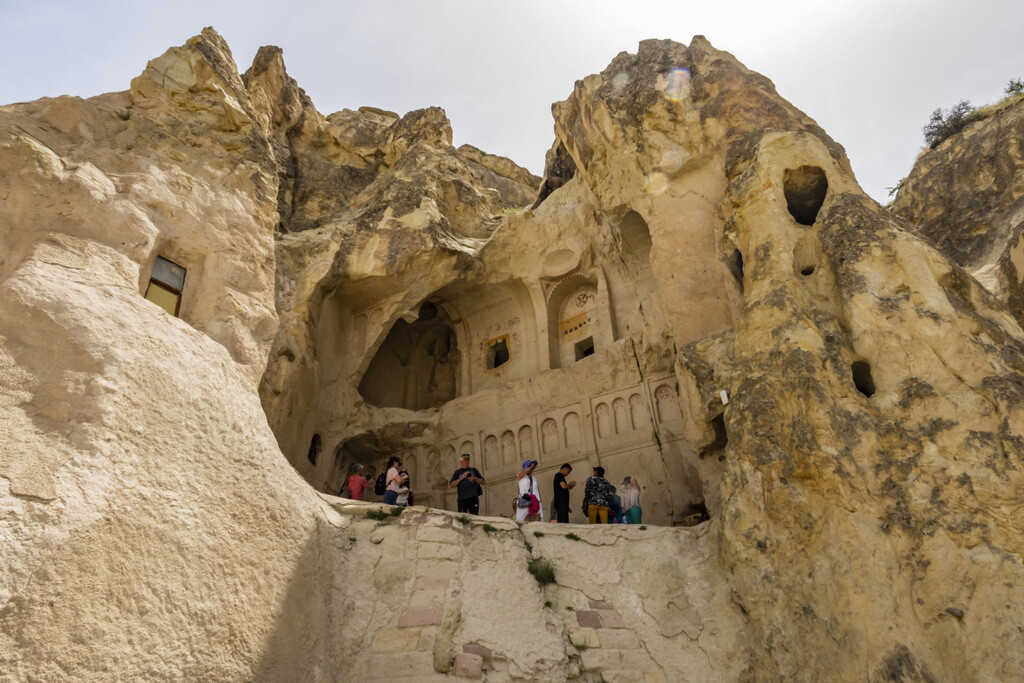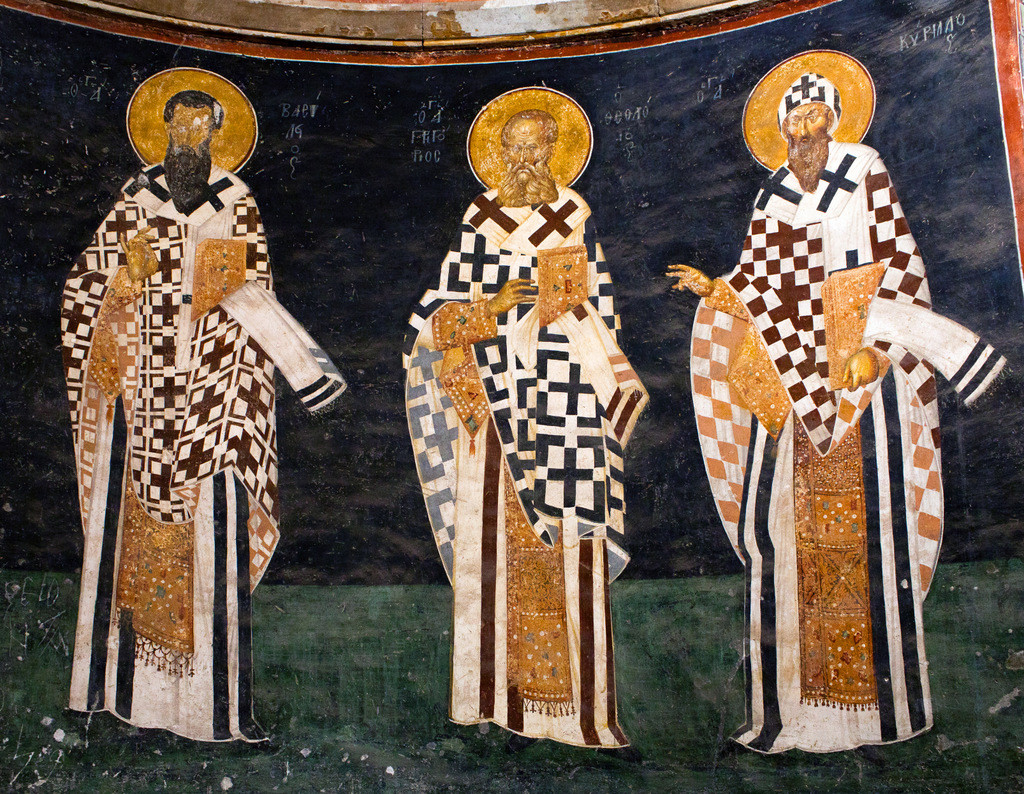In the early years of Christianity, Anatolia was one of the regions where the apostles spread Christianity. For this reason, ancient cities of Anatolia such as Ephesus and Antioch are on the pilgrimage route of Christians. Another place that Christians want to see in Turkey is Cappadocia and its cave monasteries. These monasteries are from the Byzantine period when monastic life was at its peak in Cappadocia.
In addition, some early Church Fathers, who were recognized and respected by all sects of Christianity, also lived in Anatolia. Examples include St. Nicholas, Basil the Great and John Chrysostom.
Saint Basil, one of the three important saints mentioned in the upper line, was born in Caesarea (Kayseri) in 330. Bringing a new discipline to the early monastery life, Saint Basil the Great is highly respected in churches all over the world, especially in the Orthodox Christian church.
First Examples of Christian Monasticism
The spread of Christianity began with Jesus’ death in 30s. The apostles went to the prominent cities of the ancient world, spreading Christianity. St. Peter, the most important apostle of Jesus, founded the Cave Church of Saint Peter in Antioch. St. John came to Ephesus with the Virgin Mary. Today, the house of the Virgin Mary and St. John’s Basilica can still be seen in Ephesus.
However, Christianity, which began to spread rapidly, was not welcomed by the Roman Empire. Romans with polytheistic religion followed a policy of persecution over Christianity for years. During this period, those who died for Christianity became martyrs. St. George, a Roman officer, was one of the most famous figures of this period. There are many churches in Turkey dedicated to him.
There is a 300-year period in which Christians had to hide for worship. During this period, Cappadocia region was one of the most popular places. Christians hiding in underground cities such as Derinkuyu and Kaymakli were finally freed in 313 with the Edict of Milan issued by Emperor Constantine.
The principles of Christianity were determined by the First Council of Nicaea. In half a century from Emperor Constantine to Emperor Theodosius, Christianity became the state religion of Rome. The first examples of Christian Monasticism emerged under these favorable conditions.
The faithful Christians, who followed the suffering of Jesus, wanted to live like him. A chapter in the Bible that describes the retreat of Jesus in the desert was an example of monks. It is believed that Jesus fasted in the desert for 40 days and 40 nights and resisted Satan’s temptations.
The first monk to retreat to practice Jesus’ example was Saint Anthony the Great. This cleric, also known as “Saint Anthony of Egypt”, opened a new chapter in Christian worship. Today there is a monastery in Egypt dedicated to Saint Anthony. The Monastery of Saint Anthony whose picture you can see above, symbolizes such a deep history.
Cave Monasteries in Cappadocia
Living the monk’s life soon became popular. Young and passionate Christians wanted to push the limits of human will. They also wanted to experience the simple life that Jesus recommended. There was no traditional example of monastic life in the early period. Individuals followed their own path and did not recognize the authority of the church that organized Christianity.
The most famous monk of early Christianity Saint Simeon Stylites was a “Column Saint”. Although it may seem strange at first glance, St. Simeon was undoubtedly the most popular person of this period. Simeon, who began to live on a rock near today’s city of Aleppo, then turned his residence into a column and spent his life there. People who admired his will showed up every day and brought him food and water.
Simeon’s fame spread throughout the Christian world, and his place became a center of pilgrimage. Many monks followed the path he opened. There lived another monk named Simeon Stylites the Younger, who followed the example of the first Saint Simeon. Today there is a church dedicated to Simeon Stylites the Younger in Cappadocia and a monastery in Antioch (now Antakya).
The reason I explained this was how early Christian monks followed an improvised method. Those who wanted to retreat also flocked to Cappadocia, which was a convenient geography. The main reason for this was the tufted soil of Cappadocia, which could be easily shaped with simple cutting tools. Thus, the first examples of cave monasteries in Cappadocia were built. In the early period of monastic life in Cappadocia, single-person caves were common.
Anatolian Christians, who wanted to isolate themselves from society, settled in the caves here in the 4th century. But the people who were in seclusion had to eat something. They could only meet their needs with the help of people around, like Simeon in the previous example. This system, which the monks had always consumed and never participated in production, would create social problems.
The Rule of Saint Basil the Great
Saint Basil the Great was born in 329 in Caesarea (now Kayseri). Caesarea a city in the Cappadocia region, was one of the most important Christian centers of Eastern Anatolia. In time, Saint Basil ascended to the bishop of Caesarea and became the highest ranking cleric in the city.
Touring the valleys of Cappadocia, Basil examined the life of the monks. No matter how admirable the monks endured, it produced no value for society. It was also outside the church organization represented by Basil the Great.
He decided to gather the Christian monks, which had spread to the valleys of Cappadocia, under a new discipline. Accordingly, the monks would live in small groups, not alone. Within each monastery there would be a certain hierarchy and would be ruled with absolute discipline. The monks would be under the domination of the bishop of the city and would follow the order of the church.
In the monasteries there would be chapels to pray alone, as well as dining rooms that would make a common life possible. Cappadocia Monasteries would produce their own food in the garden of the church and would not depend on the outside. Thus, small groups of monks in the monasteries would also participate in production and lead a life in harmony with society.
These rules set by St. Basil set an example for monastic life all over the world. Because of this important role in Christianity, St. Basil is respected in all Christian sects. He was honored as one of the three great patriarchs in the Eastern Church.
The saints, known as the Three Holy Hierarchs, are Basil of Caesarea, Gregory of Nazianzus, and John Chrysostom of Antioch. The relics of these three scholars can now be seen in the Patriarchal Church of St George in Istanbul.
Monastic Life in Byzantine Cappadocia
Volcanic lands formed in millions of years after the eruption of volcanoes in Cappadocia made a unique monastic life possible here. The fairy-tale geography of Cappadocia allowed the monks to dedicate themselves to Jesus as if they were in another world.
Those who visit Cappadocia today visit the monastery churches, the foundation of which was laid by Saint Basil. Examples of monastery life in Cappadocia can be seen in all Cappadocia valleys, especially the Ihlara Valley and Goreme Open Air Museum.
Monastic life in Byzantine Cappadocia peaked between the 11th and 13th centuries. Today, traces of that period can still be seen in Byzantine mosaics in the cave churches of Cappadocia.
Of course, it is difficult to understand the perspective of people who lived in the Middle Ages under the conditions of today. In order to understand how the people of that time devoted themselves to monkhood, it is necessary to read the life of religious scholars such as St. Simeon, St. Basil and St. Antonius.
By reading the lives of these early religious scholars, you can add a special meaning to your visit to the rock churches of Cappadocia. The Dark Church, Buckle Church and Selime Monastery in Cappadocia enable you to trace this period.
More About Cappadocia
Cappadocia is one of Turkey’s most important tourist destinations. If you are planning a trip to Cappadocia, you can review the comprehensive articles on this site. I would like to suggest you three articles about this region:
In order to decide where to stay in Cappadocia, the best cave hotels in Cappadocia blog post may be helpful. If you are preparing a travel itinerary in Cappadocia, the article on things to do in Cappadocia may be of use to you.
Finally, you can read the Cappadocia hot air balloon article, which provides a lot of information about the most popular activity of Cappadocia, the balloon tours. Joining a balloon flight in Cappadocia will give you the opportunity to take amazing photos of the volcanic formations.
Written by Serhat Engul




Leave a Reply